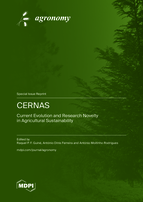CERNAS – Current Evolution and Research Novelty in Agricultural Sustainability
A special issue of Agronomy (ISSN 2073-4395). This special issue belongs to the section "Farming Sustainability".
Deadline for manuscript submissions: closed (30 September 2023) | Viewed by 53647
Special Issue Editors
Interests: food chemistry; food engineering; nutrition; sustainable agriculture; food science
Special Issues, Collections and Topics in MDPI journals
2. Coimbra Agriculture School, Polytechnic of Coimbra, Bencanta, 3045-601 Coimbra, Portugal
Interests: wildfires; sustainable land management; conservation of natural resources
Special Issues, Collections and Topics in MDPI journals
Special Issue Information
Dear colleagues,
Climate changes pose overwhelming impacts on primary production and, consequently, on agricultural and animal farming. Additionally, at present, agriculture still depends strongly on fossil fuels both for energy and production factors such as synthetized inorganic fertilizers and harmful chemicals such as pesticides.
The need to feed the growing world population poses many challenges. The need to reduce environmental impacts to a minimum, maintain healthy ecosystems, and improve soil microbiota are central to ensuring a promising future for coming generations. Livestock production under cover crop systems helps to alleviate compaction so that oxygen and water can sufficiently flow in the soil, adds organic matter, and helps hold soil in place, reducing crusting and protecting against erosion. The use of organic plant production practices allied to the control of substances used in agriculture also decisively contributes to alleviate the pressure on ecosystems.
Some of the goals of this new decade are to use enhanced sustainable productive methodologies, to improve the input/output ratios of primary production, to reduce the environmental impacts, and to rely on new innovative technologies.
Prof. Dr. Raquel P. F. Guine
Prof. Dr. António Dinis Ferreira
Prof. Dr. António Moitinho Rodrigues
Guest Editors
Manuscript Submission Information
Manuscripts should be submitted online at www.mdpi.com by registering and logging in to this website. Once you are registered, click here to go to the submission form. Manuscripts can be submitted until the deadline. All submissions that pass pre-check are peer-reviewed. Accepted papers will be published continuously in the journal (as soon as accepted) and will be listed together on the special issue website. Research articles, review articles as well as short communications are invited. For planned papers, a title and short abstract (about 100 words) can be sent to the Editorial Office for announcement on this website.
Submitted manuscripts should not have been published previously, nor be under consideration for publication elsewhere (except conference proceedings papers). All manuscripts are thoroughly refereed through a single-blind peer-review process. A guide for authors and other relevant information for submission of manuscripts is available on the Instructions for Authors page. Agronomy is an international peer-reviewed open access monthly journal published by MDPI.
Please visit the Instructions for Authors page before submitting a manuscript. The Article Processing Charge (APC) for publication in this open access journal is 2600 CHF (Swiss Francs). Submitted papers should be well formatted and use good English. Authors may use MDPI's English editing service prior to publication or during author revisions.
Keywords
- sustainable agriculture
- family farming
- organic farming
- sustainable food chain
- wildfires
- sustainable land management
- conservation of natural resources
- extensive and organic livestock farming
- freshwater fish farming
- urban agriculture








